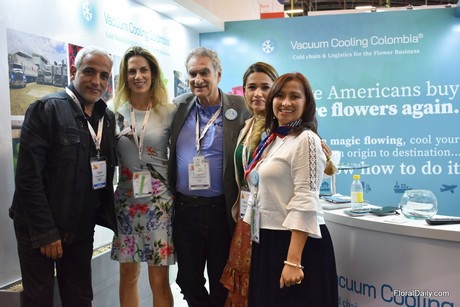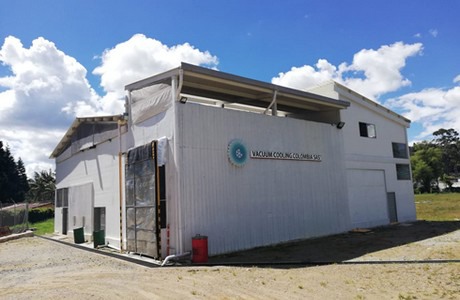"Ensure a solid cold chain process for consolidated shipments." That was the aim of Vacuum Cooling Colombia when they decided to set up a second operation in Medellin, Colombia. They opened their new operation with vacuum cooler in Guarne (Medellin) in August 2018 at a strategic location; 6 minutes away from Medellin (MDE) airport and 300 meters away from the main highway to the airports and ports. On top of that, they also found a niche in the hydrangeas. Now, more than a year later, Mauricio Gleiser, owner of Vacuum Cooling Colombia, has seen the demand growing.

The team of Vacuum Cooling (with Mauricio Gleiser in the middle) at the Proflora 2019, in Bogota, Colombia.
The problem - no solid cold chain
After years of vacuum cooling at their first operation at the Tarmac of Rionegro airport (MDE- Medellin), Gleiser and his team realized that the floral industry of Antioquia changed which caused various problems not only at the airport, but at domestic transport as well. At the airport, proper handling of the loads is the major problem. "The hydrangea production, for example, increased significantly and is now composed out of several hundreds of small and medium sized growers. As a result, most of all flowers arrived at the airport are delivered on hundreds of small trucks from many different farms and shippers of all kinds. It caused long lines and many hours to offload, since the airport lacked enough entries to receive flower boxes and cold rooms to consolidate and further store in pallets, especially during the high seasons."
Besides, a lot of flowers are also transported within the country, affecting the quality of the crop. “Many people send flowers from Medellin to bouquet makers or to airlines in Bogota (for transshipment). They used to send those flowers on passenger airlines (handled as luggage) or in trucks of all types - it wasn't possible to use reefer trucks."
Niche in hydrangea
Hydrangea is an important crop grown and shipped out of Medellin. However, as the cold chain is not solid, growers often receive claims. "Importers are used to finding botrytis and various damages even in their regular air shipments of such species. In turn, significant claims and credits are often imposed to growers." Vacuum cooling can offer a solution as it has been proven to work significantly well for hydrangea flowers.

The new facility.
On the search for solution - a strategic location
So, how to incorporate vacuum cooling and create a solid cold chain? The various problems, like reception through several entries, more cold storage area, difficult access, wrong transportation mode, nor the type of vehicle, became clear and the search for a solution took off.
They decided to set up a facility - a consolidation point - both close to the airport of Medellin and very accessible for the farms. "At our new facility, there is much less traffic than at the airport and we can operate 24/7", says Gleiser. The new operation opened in August 2018. It is established at a strategic location; 6 minutes away from MDE airport and 300 meters away from the main highway (MDE/BOG/ports) with ample apron and loading dock area.
According to Gleiser, this new facility with state of the art vacuum cooler will help meet the growing demand for consolidation, precooling, cold storage and multimodal logistics in a safe location for the Medellin (antioquia) flowers. Ït has a 200 m2 cold room, 3 reception entries (one x-ray equipped and one attached with a weather insulated tunnel/hydraulic elevator sealed dock for reefer containers).
How does it work?
So, when all trucks arrive at this location, what are the next steps? "Pallets are built up, stored in the cold room and vacuum cooled. Then, directly moved to the maritime reefer container, before going to any Colombian port (or truck if destined to MDE or BOG airport or to a bouquet assembler)."
The temperature is being recorded several times - at the reception from farms, then at the beginning of the vacuum cooling process, and they do the same when the flowers leave to the process upon loading the truck or container.
The vacuum cooling process is based on the fact that water boils at lower temperatures at lower pressures. "At about 1/100th atmosphere pressure, water boils at 32°f (0ºc). When flowers or plants are placed at these low pressures, the water in their cells ‘boils’, removing heat, advantages of vacuum cooling methods include that paper and plastic packaging materials in the boxes do not affect the efficiency of cooling, free water is removed, as described by PhD George Staby. White Paper III."
Trucks being filled with flowers that have been consolidated and vacuum cooled.
Increase in demand - also used for sea transport
Due to the shortage of airfreight space, rate increases and airport terminal reconstruction, Gleiser has demand for alternatives grow over the last year, as well as the demand for the use of their new facility. “Many exporters and their customers abroad, pressured by the lack of space on board air freighters out of MDE and induced by various logistics handlers, rushed into loading their flowers in refrigerated trucks or containers, but neglecting the necessary pre-cooling (to 1-2ºc). Most of them suffered substantial losses and got burned from their maritime experiences. Those who attempted to ship them via maritime (not using vacuum cooling) experienced extensive damages."
A long time myth (“flowers cannot travel on ships”) was recreated and the maritime alternative was somewhat hurt, explains Gleiser. "However, some of our former customers via air gave us a chance and proved by themselves that vacuum cooling prior to their shipments via maritime reefers or trucks end up in excellent results: all of our containers shipped to Miami and the west coast arrived in perfect conditions and now the customers are coming back."
How to grow the flower consumption in the USA?
Increasing the flower consumption in the USA is an often heard topic. It is well known (and even documented) that the USA market has a very low per capita consumption (as compared to the UK and EU countries). It is highly concentrated on a few holidays and very low everyday sales. "Those characteristics impose all kinds of problems (mainly infrastructural and labor) at all levels of the industry", adds Gleiser.
"Overall (low) efficiency is countered with a continuous war on prices which further affects quality and feeds the vicious cycle that reduced the consumer basis from about half to only 35 % of the Americans (1990-2018). The UK experience within 2000-2017, proved that a new culture of everyday sales (buying for own satisfaction) could be acquired and by the same token, growing USA market fourfold in 15 years is feasible."
What precludes growth is the consumers´ perception of low value that the current logistics model manages to “gain” year after year, explains Gleiser. Every holiday gives the industry a unique chance to impress consumers, but this can be either positive or negative. "The industry can impress consumers with the fascination of beautiful flowers that last long enough and exceeds their expectations or…..to supply them with the worst value at the highest prices, which is exactly what happens, and make them run away to substitutes."
And logistics play a major role in the story. "Should an improved logistics feed the 'holiday suppliers' with products, worth promoting and guaranteeing consumers with the satisfaction they look for (and deserve), then a substantial growth should come, mostly for everyday consumption."
This is where maritime shipments come in. "When using the right protocol (vacuum cooling at origin) they can solve the equation, by providing higher and consistent quality at lower costs and much closer to the various end markets."
"And if the above were not good enough, the carbon footprint of logistics only can be reduced by 90%, if compared to the airfreight. Millennials, Centennials and other age groups shall appreciate that."
Innovation to add value
"Innovation is not valuable per se, but only because it can add value, reduce costs, ensure consistency and tractability, all these urgently needed by the floral industry", Gleiser concludes.
For more information
Vacuum Cooling Colombia LTD
Mauricio Gleiser
Email: [email protected]
www.vacuumcooling.ws
